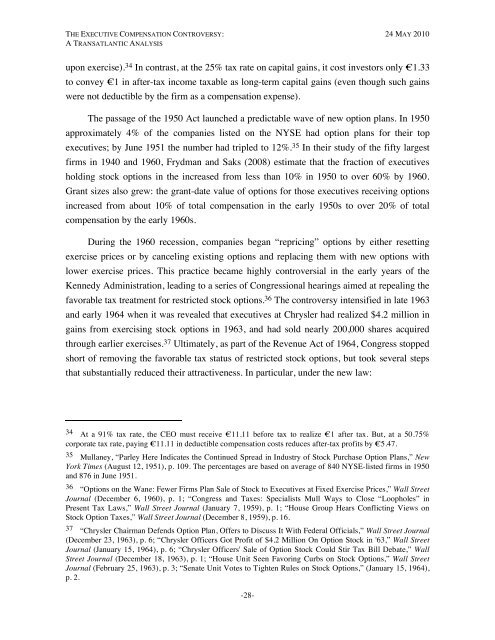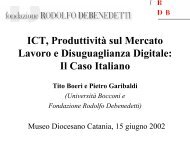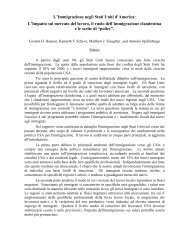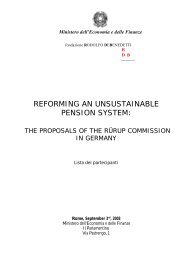The Executive Compensation Controversy - Fondazione Rodolfo ...
The Executive Compensation Controversy - Fondazione Rodolfo ...
The Executive Compensation Controversy - Fondazione Rodolfo ...
You also want an ePaper? Increase the reach of your titles
YUMPU automatically turns print PDFs into web optimized ePapers that Google loves.
THE EXECUTIVE COMPENSATION CONTROVERSY: 24 MAY 2010A TRANSATLANTIC ANALYSISupon exercise). 34 In contrast, at the 25% tax rate on capital gains, it cost investors only €1.33to convey €1 in after-tax income taxable as long-term capital gains (even though such gainswere not deductible by the firm as a compensation expense).<strong>The</strong> passage of the 1950 Act launched a predictable wave of new option plans. In 1950approximately 4% of the companies listed on the NYSE had option plans for their topexecutives; by June 1951 the number had tripled to 12%. 35 In their study of the fifty largestfirms in 1940 and 1960, Frydman and Saks (2008) estimate that the fraction of executivesholding stock options in the increased from less than 10% in 1950 to over 60% by 1960.Grant sizes also grew: the grant-date value of options for those executives receiving optionsincreased from about 10% of total compensation in the early 1950s to over 20% of totalcompensation by the early 1960s.During the 1960 recession, companies began “repricing” options by either resettingexercise prices or by canceling existing options and replacing them with new options withlower exercise prices. This practice became highly controversial in the early years of theKennedy Administration, leading to a series of Congressional hearings aimed at repealing thefavorable tax treatment for restricted stock options. 36 <strong>The</strong> controversy intensified in late 1963and early 1964 when it was revealed that executives at Chrysler had realized $4.2 million ingains from exercising stock options in 1963, and had sold nearly 200,000 shares acquiredthrough earlier exercises. 37 Ultimately, as part of the Revenue Act of 1964, Congress stoppedshort of removing the favorable tax status of restricted stock options, but took several stepsthat substantially reduced their attractiveness. In particular, under the new law:34 At a 91% tax rate, the CEO must receive €11.11 before tax to realize €1 after tax. But, at a 50.75%corporate tax rate, paying €11.11 in deductible compensation costs reduces after-tax profits by €5.47.35 Mullaney, “Parley Here Indicates the Continued Spread in Industry of Stock Purchase Option Plans,” NewYork Times (August 12, 1951), p. 109. <strong>The</strong> percentages are based on average of 840 NYSE-listed firms in 1950and 876 in June 1951.36 “Options on the Wane: Fewer Firms Plan Sale of Stock to <strong>Executive</strong>s at Fixed Exercise Prices,” Wall StreetJournal (December 6, 1960), p. 1; “Congress and Taxes: Specialists Mull Ways to Close “Loopholes” inPresent Tax Laws,” Wall Street Journal (January 7, 1959), p. 1; “House Group Hears Conflicting Views onStock Option Taxes,” Wall Street Journal (December 8, 1959), p. 16.37 “Chrysler Chairman Defends Option Plan, Offers to Discuss It With Federal Officials,” Wall Street Journal(December 23, 1963), p. 6; “Chrysler Officers Got Profit of $4.2 Million On Option Stock in '63,” Wall StreetJournal (January 15, 1964), p. 6; “Chrysler Officers' Sale of Option Stock Could Stir Tax Bill Debate,” WallStreet Journal (December 18, 1963), p. 1; “House Unit Seen Favoring Curbs on Stock Options,” Wall StreetJournal (February 25, 1963), p. 3; “Senate Unit Votes to Tighten Rules on Stock Options,” (January 15, 1964),p. 2.-28-









